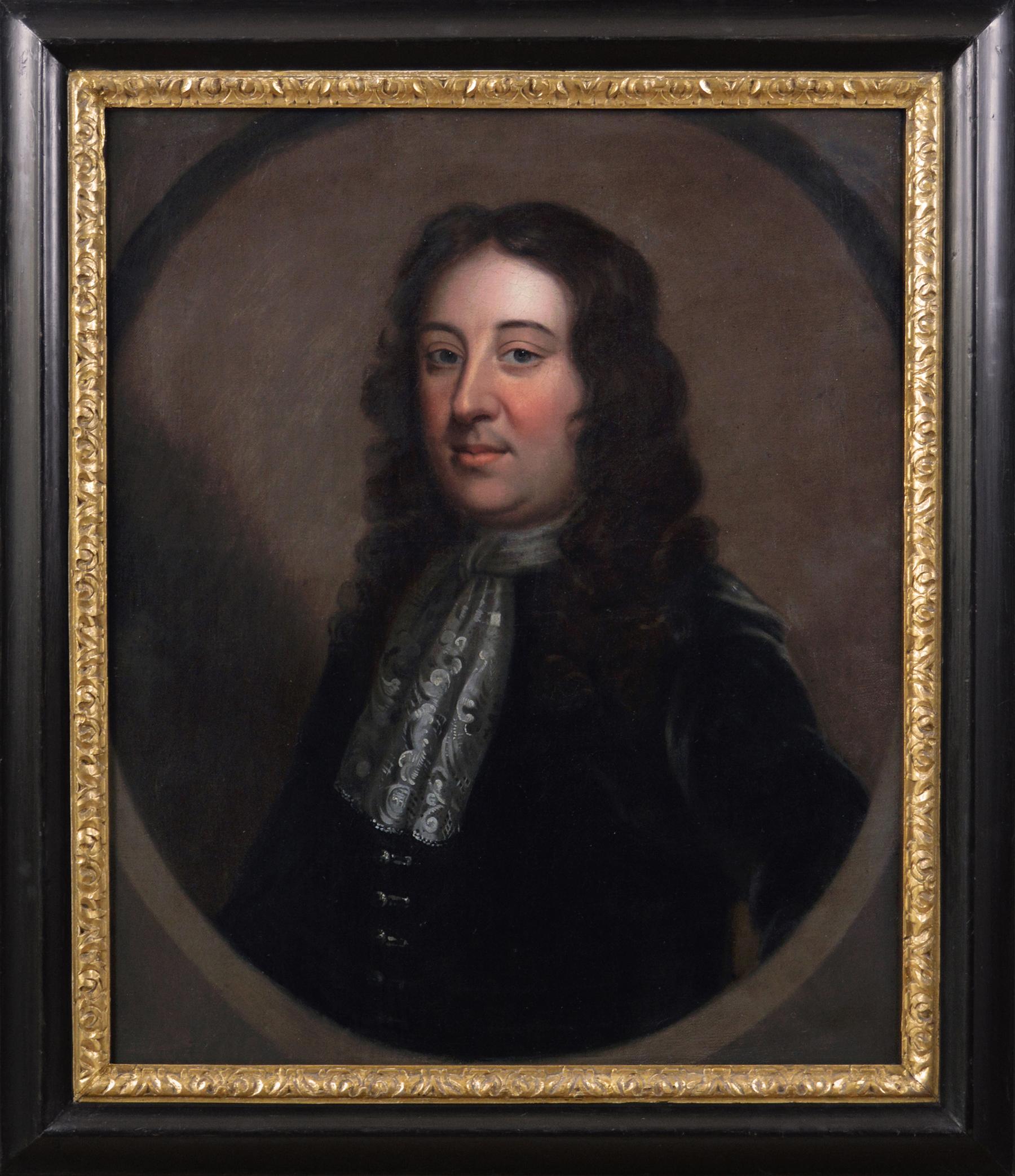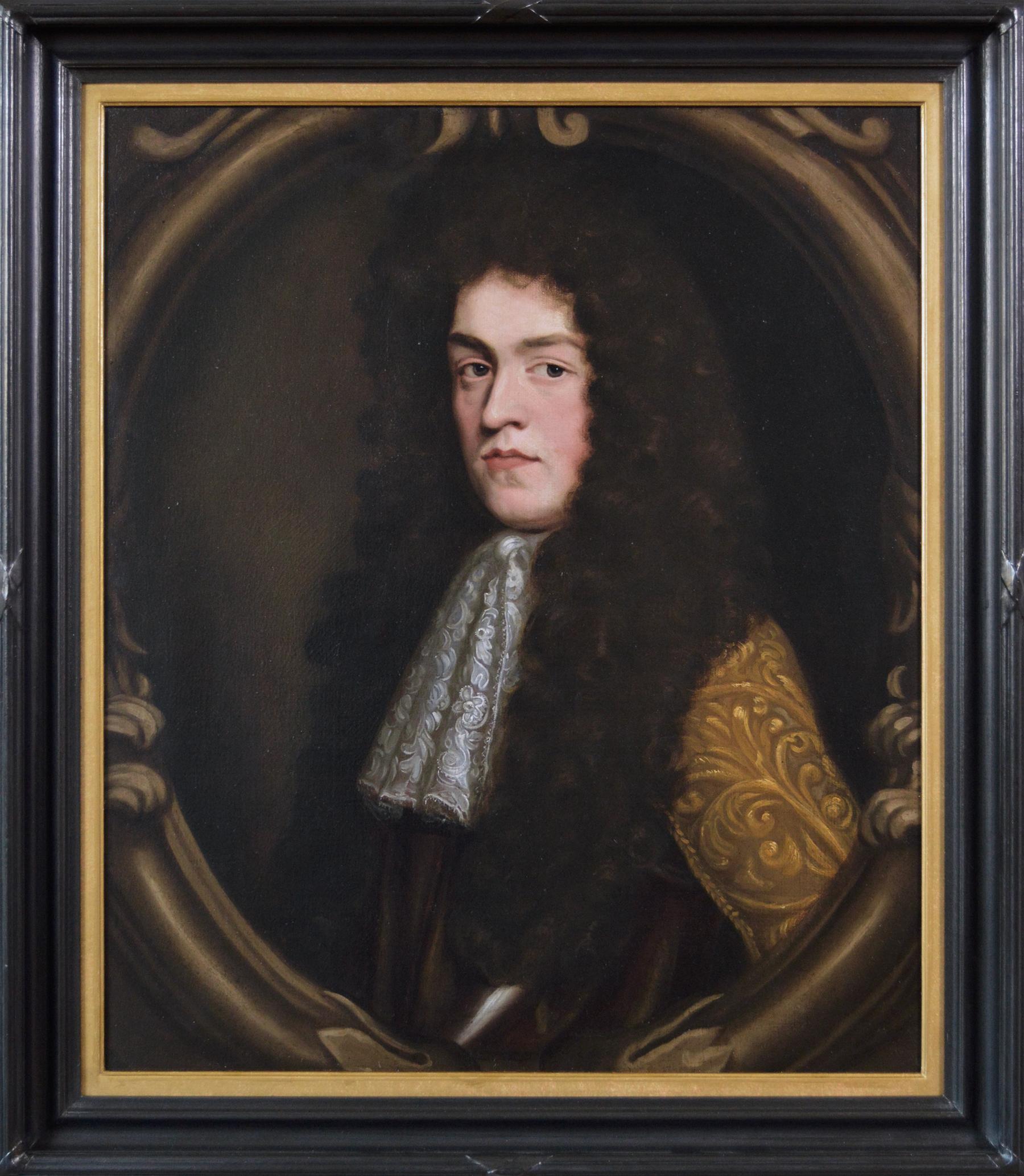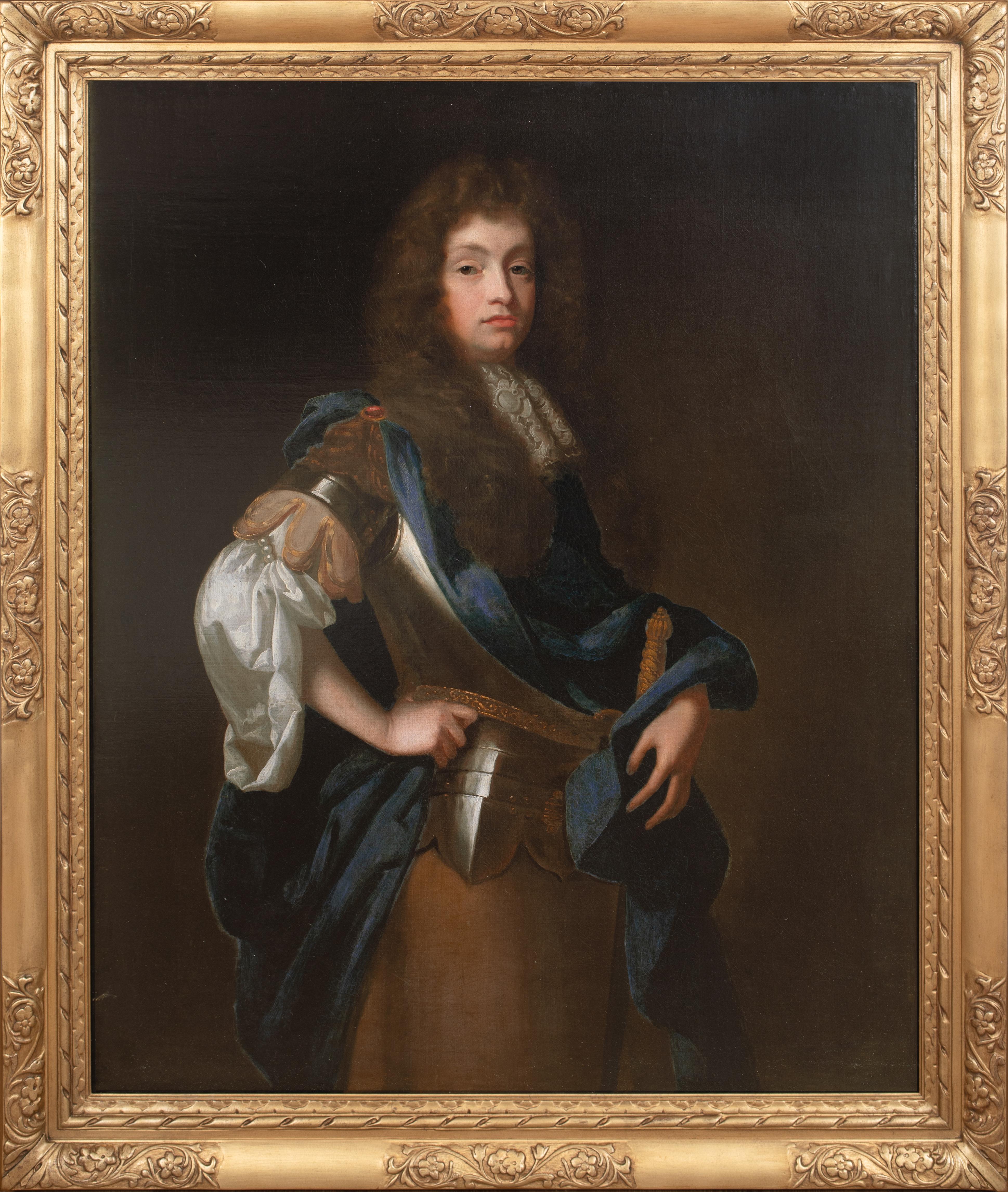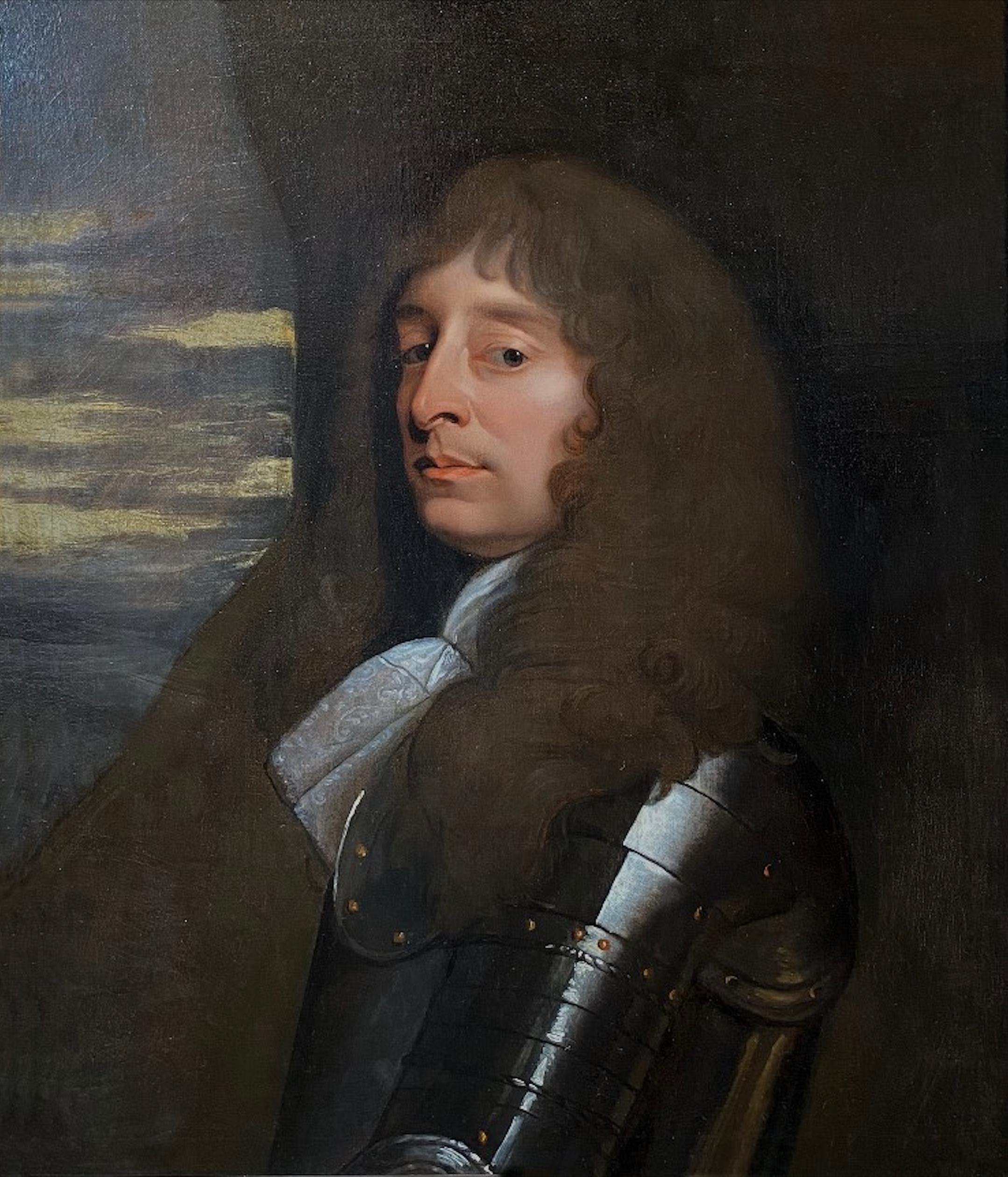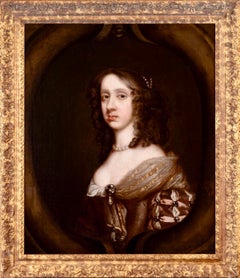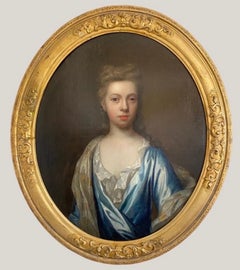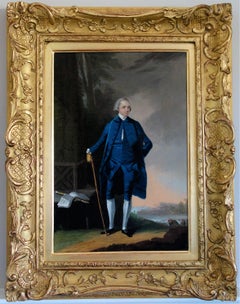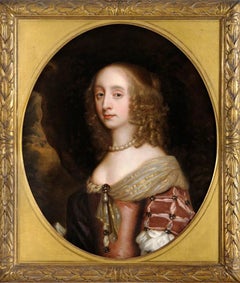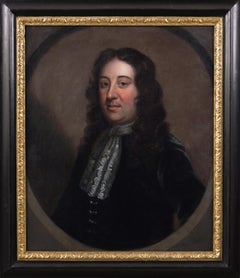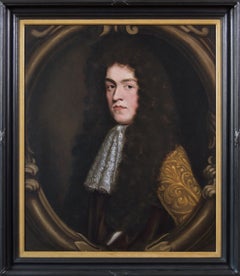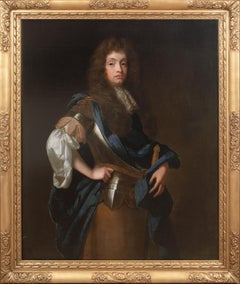Items Similar to English 17th century portrait of John Ludford Esquire
Want more images or videos?
Request additional images or videos from the seller
1 of 11
English 17th century portrait of John Ludford Esquirec.1680
c.1680
$12,168.31
$15,210.3820% Off
£8,800
£11,00020% Off
€10,370.12
€12,962.6520% Off
CA$16,859.80
CA$21,074.7520% Off
A$18,306.46
A$22,883.0820% Off
CHF 9,694.61
CHF 12,118.2620% Off
MX$224,384.79
MX$280,480.9920% Off
NOK 119,974.64
NOK 149,968.2920% Off
SEK 113,369.68
SEK 141,712.1020% Off
DKK 77,398.34
DKK 96,747.9220% Off
About the Item
Portrait of John Ludford (1653-1681), wearing a lace jabot and brown and gold trimmed cloak in a feigned stone oval cartouche. Inscribed 'John Ludford, Esq, nat. 14th March 1653, Ob, 15th September 1681', with old plaque titled 'Mary Beale'
Provenance: Private collection, Surrey
Mary Beale (born Craddock in March 1633) was a prolific English portrait painter, becoming one of the most important portrait painters of the middle classes in 17th century England, being described as one of the first professional female English portrait painters. Her sitters included her family, her immediate circle of friends, particularly the protestant clergy, the landed gentry and nobility.
She was born in Barrow, Suffolk where her father was a rector and she married Charles Beale in 1651. She possibly studied under Robert Walker but later was chiefly influenced by Peter Lely who was a friend and whose work he sometimes allowed her to make copies of. Her most active period was in the 1670's and 80's. After Charles's employment in the government patents office came to an end and Mary`s painting became the principle source of income for the family, Charles worked alongside Mary in managed her studio, mixing her paints and keeping detailed notes of her studio activities and commissions. The notebooks for 1677 and 1681 survive and are found at the Bodleian Library, Oxford and The National Portrait Gallery, London, and Vertue published partial transcripts of others.
Mary Beale was ahead of her time as a woman in 17th century England as not only was she successful as an artist in a working environment dominated by men, but during a stay in the country whilst escaping London from the plague of 1666, she wrote about her views on equality between men and women in marriage in her 'Discourse on Friendship', putting into practice these beliefs in her own life.
Her work often displays her talent in depicting her subjects with a particular sensitivity and empathy such as in the intimate portraits of her two young sons, Bartholomew and Charles, found in Tate Britain, London and in her own self portrait in the National Portrait Gallery, London. She died in Pall Mall and was buried in St James's London in October 1699.
Literature:
Walsh and Jeffree The Excellent Mrs Mary Beale 1975/6
Tabitha Barber Mary Beale - Portrait of a seventeenth century painter, her family and her studio 1999.
About the Seller
5.0
Vetted Professional Seller
Every seller passes strict standards for authenticity and reliability
Established in 2002
1stDibs seller since 2015
37 sales on 1stDibs
Associations
The British Antique Dealers' AssociationLAPADA - The Association of Arts & Antiques DealersInternational Confederation of Art and Antique Dealers' Associations
- ShippingRetrieving quote...Shipping from: Bath, United Kingdom
- Return Policy
Authenticity Guarantee
In the unlikely event there’s an issue with an item’s authenticity, contact us within 1 year for a full refund. DetailsMoney-Back Guarantee
If your item is not as described, is damaged in transit, or does not arrive, contact us within 7 days for a full refund. Details24-Hour Cancellation
You have a 24-hour grace period in which to reconsider your purchase, with no questions asked.Vetted Professional Sellers
Our world-class sellers must adhere to strict standards for service and quality, maintaining the integrity of our listings.Price-Match Guarantee
If you find that a seller listed the same item for a lower price elsewhere, we’ll match it.Trusted Global Delivery
Our best-in-class carrier network provides specialized shipping options worldwide, including custom delivery.More From This Seller
View All17th century English portrait of a lady
By Willem Wissing
Located in Bath, Somerset
Portrait of a lady attributed to William Wissing, half-length, wearing a pearl necklace and an amber gown adorned with jewels to the bodice and sleeves, wit...
Category
17th Century Old Masters Portrait Paintings
Materials
Canvas, Oil
English 18th century portrait of a lady, Circle of Thomas Murray (1663-1735)
Located in Bath, Somerset
An early 18th century portrait of a young lady, half length, wearing a blue silk gown with white chemise and gold trimmed cloak draped across her arm and shoulders. Her sensitively observed soft expression and skilfully painted youthful 'dewy' complexion are reminiscent of the portrait style of John Closterman whose work Murray would have been familiar with, being a close colleague of Murray's teacher, John Riley.
An old label on the reverse identifies the sitter as a young Princess Charlotte...
Category
Early 18th Century Old Masters Portrait Paintings
Materials
Canvas, Oil
$8,296 Sale Price
20% Off
18th century portrait of the German Flautist and composer Johann Joachim Quantz
By Arthur Devis
Located in Bath, Somerset
Portrait of Johann Quantz (1697-1773), flautist and composer, wearing a blue velvet coat, waistcoat and breeches, standing in a garden landscape with ...
Category
18th Century English School Portrait Paintings
Materials
Canvas, Oil
$14,933 Sale Price
20% Off
17th century English portrait of a lady
By Sir Peter Lely
Located in Bath, Somerset
Miss Ada Gossett, circa 1673, half-length in a landscape at dusk, wearing an amber silk gown adorned with a gold trimmed gauze shawl and fine jewels, wearing a pearl necklace, her fa...
Category
17th Century Old Masters Portrait Paintings
Materials
Canvas, Oil
17th century portrait of a lady
By Nicolaes Maes
Located in Bath, Somerset
Portrait of a lady by Dutch Golden Age painter Nicolaes Maes (1634-1693). Half-length, within a feigned oval, the lady wears a pearl necklace and earrings, an ivory silk gown adorned...
Category
17th Century Old Masters Portrait Paintings
Materials
Canvas, Oil
English 17th century portrait of a lady
By Sir Peter Lely
Located in Bath, Somerset
A 17th century English portrait of a lady by Sir Peter Lely (1618-1680), half-length in a painted feigned oval, wearing a green silk gown with chestnut coloured cloak over one shoulder, her fair hair curled in the fashionable ringlet style of the period. Oil on canvas in an English giltwood 'Lely' frame.
We are grateful to Diana Dethloff and Catharine MacLeod (who are currently working on a Lely catalogue raisonné) for their confirmation of Lely as the artist from photograph analysis of this previously unidentified early work.
Provenance:
Private collection Nottingham until 2021
Mellors and Kirk sale December 2000, lot 1173
The sitter is likely to have been from an upper class or aristocratic family in court circles, who were the main source of Lely`s patronage. The simple composition serves to highlight the beauty of the sitter through portraying her pale decolletage and complexion, set against the gentle gaze of her blue eyes, the soft blush of her cheeks and her full red lips.
Peter Lely (1618-1680) was originally of dutch origin and became Principle Painter to the King in 1661, following in the footsteps of Van Dyck who had died in 1641. He dominated the portrait painting scene in England for over 20 years, creating a distinctive 'court look' in his work which had a strong influence on many other artists. He had an extremely successful and popular portrait practice which meant that he soon had to develop production methods that could accommodate the high demand for portraits, and also for copies and versions of them which were given as gifts to family and courtiers. The use of studio assistants was a common practice for busy artists and as with Van Dyck, Lely is known to have used specialist assistants to execute particular parts of his paintings. Artists who worked in Lely`s studio included John Baptist Gaspars who specialised in drapery painting, William Wissing, John Greenhill...
Category
17th Century Baroque Portrait Paintings
Materials
Canvas, Oil
$24,336 Sale Price
20% Off
You May Also Like
17th Century portrait oil painting of a gentleman
By John Riley
Located in Nr Broadway, Worcestershire
Circle of John Riley
British, (1646-1691)
Portrait of a Gentleman
Oil on canvas
Image size: 29 inches x 24 inches
Size including frame: 36 inches x 31 inch...
Category
17th Century Old Masters Portrait Paintings
Materials
Canvas, Oil
17th Century portrait oil painting of a gentleman
By Willem Wissing
Located in Nr Broadway, Worcestershire
Circle of Willem Wissing
Dutch, (1656-1687)
Portrait of a Gentleman
Oil on canvas
Image size: 29 inches x 24.5 inches
Size including frame: 35 inches x...
Category
17th Century Portrait Paintings
Materials
Canvas, Oil
Portrait of a Gentleman, 17th Century Dutch Old Masters Oil
Located in London, GB
Circle of Gerard van Honthorst
1592 - 1656
Portrait of a Gentleman
Oil on wooden panel
Image size: 29 x 23 inches
Contemporary gilt frame
Gerard van Honthorst was a Dutch Golden Age...
Category
17th Century Old Masters Portrait Paintings
Materials
Oil, Wood Panel
Portrait Of Richard Jones, 1st Earl Of Ranelagh, 17th Century SIR PETER LELY
By Sir Peter Lely
Located in Blackwater, GB
Portrait Traditionally Identified as Richard Jones, 1st Earl Of Ranelagh, 17th Century
School Of Sir Peter Lely (1618-1680)
Large 17th Century Portrait believed to be Rochard Jones...
Category
17th Century Portrait Paintings
Materials
Oil, Canvas
Old Master Portrait of a Gentleman - British 18th century oil painting
By Michael Dahl
Located in Hagley, England
This stunning 18th century Old Master portrait oil painting is attributed to Swedish born, England based artist Michael Dahl. Painted circa 1690 it is a sumptuous half length portrai...
Category
17th Century Old Masters Portrait Paintings
Materials
Oil
$10,508 Sale Price
20% Off
Portrait of a Nobleman in Armour, 17th Century Oil Painting
By Anthony van Dyck
Located in London, GB
Oil on canvas
Image size: 30 x 35 inches (76.25 x 89 cm)
Carved gilt frame
A half-length portrait of a man turned slightly to the left, gazing at the spectator, standing, wearing st...
Category
17th Century Portrait Paintings
Materials
Canvas, Oil
